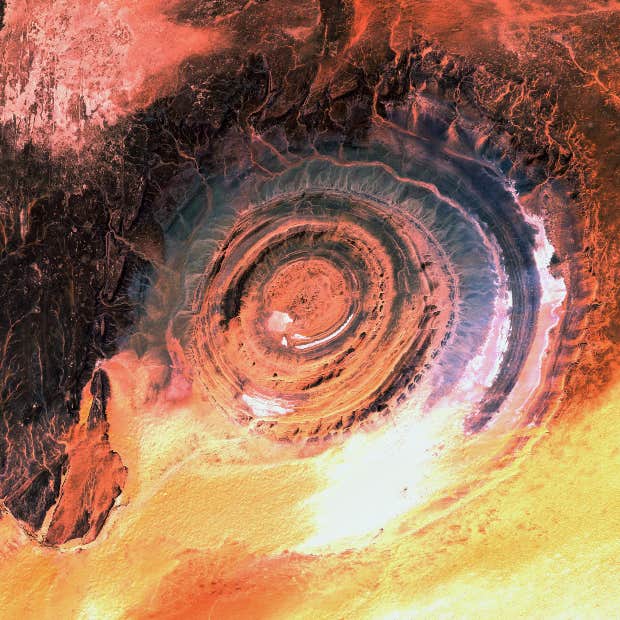The Compelling Theory That The Lost City Of Atlantis Is Hiding In Plain Sight
The facts seem to align.
 stock_colors / Getty Images, Edward Olive via Canva
stock_colors / Getty Images, Edward Olive via Canva There are many mysterious places around the world that boggle the mind. If you dig deep enough, many of them have logical explanations for their existence. Others are the subjects of myths and legends and the truth will likely remain hidden.
One of the most talked-about geological phenomena is known as the Eye of the Sahara, or the Richat Structure. And it may be linked to a fictional and well-known Lost City.
What is the Eye of the Sahara?
The Richat Structure is a formation of sedimentary rock that lies in the Sahara desert of Mauritania. It was named the "Eye of the Sahara" because it can be viewed from space and is used to guide astronauts on the International Space Station.
The structure is about a 30-mile-wide circular structure that has the appearance of a bullseye in the middle of the desert. Scientists first believed that the Richat Structure started as an impact crater from a meteorite. But the geological features did not confirm that theory.
 Photo: Wikimedia Commons / Creative Commons Attribution-ShareAlike 3.0 IGO
Photo: Wikimedia Commons / Creative Commons Attribution-ShareAlike 3.0 IGO
Another idea was that it is a dome that has eroded, exposing many layers of rock that have formed symmetrical rings around it with the oldest ones on the outer edges of the structure.
But recently, scholars have offered that the Richat Structure is about 100 million years old and is the result of volcanic activity.
They hypothesize that a huge cavern filled with magma formed and caused the surface of the Earth to bulge upward into a dome. They think that the limestone was hydrothermally altered, and the structure got weak and collapsed.
It is believed that the surface, through thousands of years of erosion, formed the rings and valleys. In the dome, molten rock is thought to have formed the breccia massif, a rock that is composed of smaller rocks fused together.
Yet another theory on the Richat Structure is that the supercontinent, Pangaea, broke apart, allowing the Atlantic Ocean to flow in while magma below the surface pushed up from Earth’s mantle, forming a circular rocky dome enclosed in layers of sandstone.
But its origins are still a source of much debate. One prevailing thought is that the Eye of the Sahara is actually the mythical Lost City of Atlantis.
What is the Lost City of Atlantis?
Grecian philosopher Plato wrote about the Lost City of Atlantis in his texts “Critias” and “Timaeus” around 360 BC. He told readers about this grand city that was destroyed 11,600 years ago.
According to Plato, Atlantis was an island run by powerful kings and also ruled other nearby islands. It was supposedly a heavily guarded city made of rings of land and water with bridges connecting them together.
Greek mythology says that Poseidon, the God of the Sea, happened upon Atlantis and found it inhabited by the smartest and most beautiful people on Earth, including his true love, Cleito.
In totally toxic fashion, Poseidon kept other suitors at bay by putting Cleito in a palace surrounded by moats. They couple had five sets of twins, all boys, and the first one, Atlas, would become the King of Atlantis and the namesake of the Atlantic Ocean.
Atlantis was apparently the picture of opulence and status where the wealthy lived, the technology was advanced and the military was powerful. The inhabitants were rumored to be extraterrestrial, taller than humans, and able to live as long as 800 years.
The people of Atlantis were believed to have the power to change the weather and create volcanic eruptions, leading to a claim that they were part human, part God.
Per the legend, Atlantis was corrupt and became overcome with greed and immorality. As punishment, the Gods sent fire and earthquakes to destroy it, causing the city to sink into the sea.
Could the Richat Structure be Atlantis?
There are many reasons people believe that the Richat Structure is the Lost City of Atlantis. From the size, time frame, the location and the geological characteristics, the theory seems to align.
The time frame lines up.
The destruction of Atlantis allegedly took place 11,600 years ago. This time frame is near Younger Dryas, a period in which large temperature fluctuations occurred, causing sea levels to rise and fall drastically and included devastating fires.
The descriptions match.
When Plato spoke of Atlantis, he talked about the concentric rings of alternating channels of water and structures, a perfect description of the Richat Structure. The water has gone, but there are pockets of salt on the surface of the sand indicating the presence of ocean water in the past 12,000 years.
The size of Atlantis corresponds with a section of Richat.
Atlantis was 14 miles across, which aligns with the center portion of Richat. Believers say that, over time, the layers of rock have expanded and there are natural geological changes that took place.
The location of Atlantis shows it could be the Richat Structure.
Another clue that the Richat Structure could be Atlantis is the location. It was in the shadow of mountains to the north with rivers flowing through them and down into a big valley. This, of course, matches the topography of the Richat Structure.
Both Richat and Atlantis appear to have emptied into the ocean.
Some claim that there is evidence that the Richat Structure, though now located in a dry, arid desert, once drained into the ocean. This suggests that it was once surrounded by water, as was Atlantis.
There are also counterarguments to the theory that Richat is Atlantis.
For every argument that the Richat Structure is the Lost City of Atlantis, there is a rebuttal.
The correlation with Younger Dryas is shot down because the timeline is off by 100 years. In addition, it happened over time while Atlantis was taken in one fell swoop.
There are also issues with the size comparison, the broken rings of the Richat Structure, the doubt that they could have been filled with water, and the idea that the 4.6-million-year-old Sahara Desert was covered in water only 12,000 years ago.
NyRee Ausler is a writer from Seattle, Washington, and author of seven books. She covers lifestyle and entertainment and news, as well as navigating the workplace and social issues.
